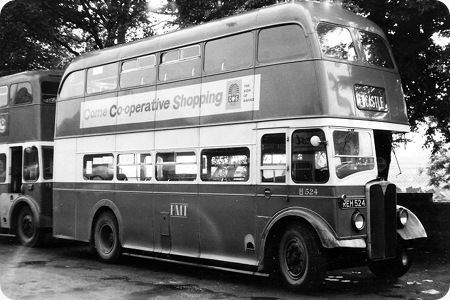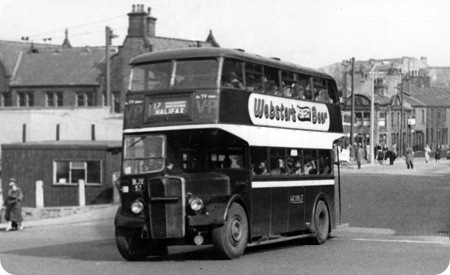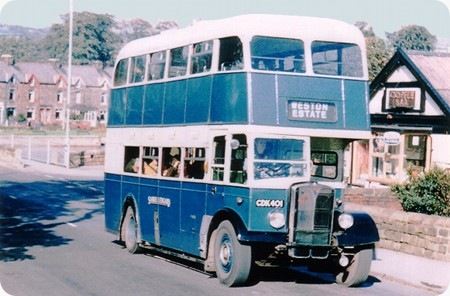
Samuel Ledgard
1948
AEC Regent III
East Lancs H33/26R
Here is a happy picture of yours truly enjoying my work immensely with Samuel Ledgard at Otley Depot. I am returning from the Estate on one of the local town services and have just crossed the River Wharfe bridge. Before I am reprimanded for "incorrect destination" I must explain that the display was officially shown in both directions as "Weston Estate" to avoid passenger confusion with the other town service which shared the river crossing – a little local quirk which suited everyone.
GDK 401 was one of a batch of five (GDK 401 – 5) which came from Rochdale in February 1962 and had most handsome and functional East Lancashire bodywork. Notable features were the superior quality blue leather seats and the spacious very safe platform and "easy" staircase. The entire batch retained gold Rochdale fleet numbers (201 – 205) in both saloons – a nice little touch I thought.
The vehicles were also the first that we had with air operated brakes and gearboxes.
A nice little anecdote, and a true one, goes with 401. When the batch was acquired this vehicle alone was sent to Otley depot for complete and prompt overhaul for early entry into service with the others at Armley Head depot. However its appeal and charms were instantly apparent to all, and in a very uncharacteristic "Luddite" operation the normally highly efficient overhaul process was delayed by a myriad of "difficulties" for a very considerable time. When the bus was eventually ready for certification the powers that be at mighty Armley, normally unbending in any way, for some reason capitulated and lovely 401 remained with us at Otley till the end of the Company. The initial very basic plans for the West Yorkshire Road Car Co takeover contained the allocation of WYRCC numbers for the whole Ledgard fleet – this scheme as we know was completely revised before the day, and so our Rochdale friend never became "DAW 1" (Double, AEC engine, Wide) after all.
Photograph and Copy contributed by Chris Youhill
Bus tickets issued by this operator can be viewed here.
Such a shame that Samuel Ledgard sold out.
It would be interesting to see what vehicles they would be running today.
Terry Malloy
Yes, it is a shame, Terry – the buses look fantastic in full livery – but fifty years down the line, is it not possible that we would be looking at them in Barbie colours? Lots of mistakes made in the industry, but death and other things have always enforced change!
David Oldfield
Quote: (Double, AEC engine, Wide)
I assume that the Wide means that it had an 8′ wide body. It certainly appears to have one, in a surprisingly obvious way, just like LT’s RTW class.
Nice to see a Ledgard vehicle in colour; it’s my first time of seeing one of them in all its glory!
By the way what is an ‘easy’ staircase?
Chris Hebbron
I’m sure Chris Youhill will fill us in about the easy staircase. Is it like the Roe safety staircase and the Birmingham staircase – straight, or with 90% bends, with no "dangerous" curves during its length?
David Oldfield
Yes Chris, the "W" in the West Yorkshire fleet numbering system did indeed mean 8 feet wide – just as an interesting point, they had some vehicles with 8 feet wide bodies on 7’6" chassis – as did a good few Bristol/ECW customers.
Chris and David, the word "easy" was just my own way of describing these vehicles – the stairs were of the 90 degree pattern and were wider than usual and were situated safely well away from the edge of a generous sized platform – somewhat difficult to explain, but splendidly designed.
Chris Youhill
A query for Chris: my hazy recollection of "Exors of Samuel Ledgard" buses- as it legally proclaimed- was that the were a dark navy blue- not this jaunty colour: 1. am I wrong? 2. does the camera lie? 3. is it anything to do with its former existence in Rochdale?
Joe
Well this is indeed an interesting point, and memory does play tricks as we all know. However I have to say that the answer lies somewhere between the shades of blue in the picture of GDK 401 and that in the link for RT MXX 148. The only fair comment I can make is that, as Peter says, the colour in the picture of GDK 401 is a bit light and bright due to the sun etc. Certainly though the shade shown in the view of the RT is far darker than the actual, and I can confidently say that the Otley picture is much nearer to being spot on than the Bradford one. The Rochdale livery is not relevant at all, as every acquired bus was thoroughly rubbed down, primed and undercoated to remove any trace whatsoever of previous ownership.
The attached view of newly acquired BCK 427 from Ribble in the paintshop at Armley Head Depot is as good a sample as we could wish for – despite the different light aspects the lower saloon panels are exactly as the livery was. Hope this helps clear the mists of time for those interested.
Chris Youhill
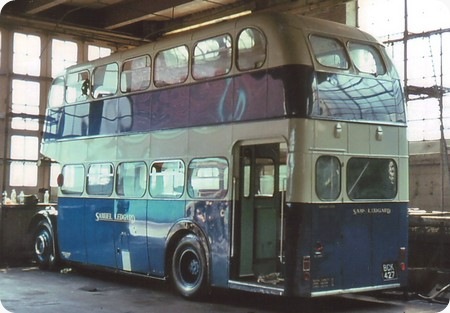
…..and there is also the splendid RLH (forget which number) which was rallying last year in full Ledgard colours. Quite a bright blue – neither royal nor navy.
David Oldfield
The purpose of the photo may well have been to clarify SL’s livery, but this is a nice photo in itself and shows off this attractive vehicle’s bodylines very well, aided by the total lack of adverts. Good to see a rear’ish view for a change.
It may be a trick of the light, but has the rear lower body panel been well punched by a very cross 10 year old?
Chris Hebbron
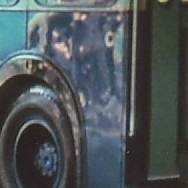
I see what you mean – the panel seems well and truly "waffled", but I think it is in fact just a mirror image of activity nearby in the garage what lloks like the floor can be seen, and possibly a mechanic’s overall legs. It is a strange optical effect, but please do rest assured that the panel will have been perfect before painting.
Chris Youhill
Hi David – the magnificent vehicle to which you refer is RLH 32 – MXX 232. It is part of the heritage fleet of Time Bus Travel of St. Albans and the proprietors, the Pring Family, did the Samuel Ledgard Society an immeasurable and generous kindness by having the bus professionally and immaculately painted in Samuel Ledgard colours for our 40th Anniversary Re-enactment running day on Sunday 14th October 2007. I was humbled and highly honoured to conduct it almost all the time it ran on Samuel Ledgard routes giving free rides to delighted and nostalgic passengers – I wore my original Samuel Ledgard uniform and used my Otley Depot Setright ticket machine – SL 40.
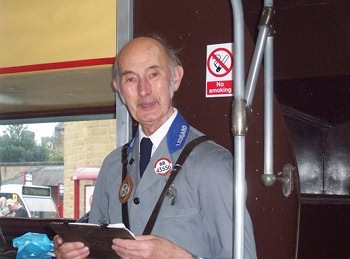
Chris Youhill
Re Chris Youhill’s latest comment about RLH 32 under the heading of AEC Regent III GDK 401, here’s a photo of the bus in question on the day in question.
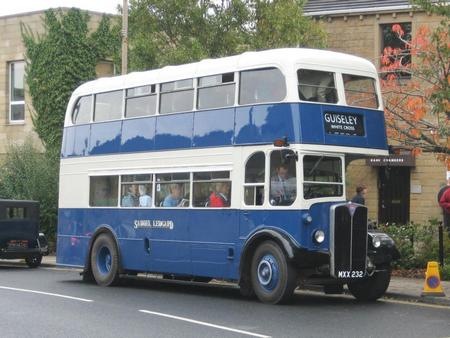
Peter Williamson
Thank you Peter W for that lovely view, which captures the atmosphere of that wonderful day perfectly. Judging by the load, the RLH is about to leave for Guiseley and the driver is Mr. Ewan Pring who handles the vehicle magnificently and sympathetically, as you would expect from the owner of such a cherished gem. While you took the photo I will have been on the platform, about to issue the authentic souvenir tickets to the passengers. I can’t begin to explain my feelings on that day which was fifty years exactly since I eagerly started work for the Company – a day on which the RLH will still, of course, have been hard at work in London !!
Chris Youhill
I’ve always been fascinated by the myriad variations on the theme of how to get passengers upstairs, so Chris Youhill’s reference to the East Lancs "easy staircase" tickled my curiosity. I imagine that, as on post-war ECW highbridge bodies until about 1957, the top step will have caused a 9"x9" protrusion into the lower saloon, above the offside transverse seat. The loss of headroom would be no more than that entailed by a lowbridge side gangway: a very small price to pay for the virtue of having the bottom step 9" farther in from the platform edge. Until the mid-1920s it seems that body designers tried to get the bottom step as NEAR as possible to the platform edge, presumably so that passengers could leap straight up top from the street, leaving the platform free for those timid souls who preferred to travel inside. I’ve never understood why this hazardous arrangement persisted so long with some makers. Lowbridge bodies needed only 7 steps (6 treads), yet Leyland and MCW, for example, never took advantage of that, preferring their top step to stop about 9" back from the bulkhead or (Leyland) to give the top two steps 13.5" treads instead of 9".
Was standardisation of parts between lowbridge and highbridge a factor?
I love the Roe Safety Staircase: by intruding into the lower saloon you can bring the bottom step well inboard and therefore have a seat for three right at the back upstairs with no risk of bumping your head on the underside of that seat. Perfectly logical: you lose a seat downstairs and gain one on top. Much rarer was the pattern found on Burnley, Colne and Nelson deckers: the 9"x9" box was moved 4" forward and the step below it protruded downstairs just enough to fill the space above your shoulder but not enough to compromise headroom. With a bit of angling of the bottom few steps the stairs still touched ground far enough from the platform edge to allow a 3-seater at the back upstairs. Do any of these survive? I fancy I came across a similar arrangement on a bus in Yorkshire (Rotherham) but my wires may be crossed. Then there was the West Bridgford arrangement, and Alan Townsin’s mention of "semi-straight"and "side" staircases in his book on Park Royal, but I’d better not get carried away…
Ian Thompson
Why not get carried away, Ian. It’s fascinating. It’s what real enthusiasm is – not just "bus spotting"! I can bore for Britain over Roe – my favourite builder – but it is interesting to discover that they weren’t the only builder doing a variation on safety staircases.
David Oldfield
wow… talk about nostalgia.
When going to Leeds I would often take "Sammy’s" route through Pudsey rather than the Leeds/Bradford joint route (72) through Stanningley Bottoms. I used the route the day after the closure. It just wasn’t the same with green municipal buses and a route number (78).
Do you have any images of my favourite Ledgard Regents, 1949/50 U before they assumed their West Yorkshire identities, DGW 11-12?
Charles
Hello Charles – fear not, there are literally dozens of pictures around showing your two favourite vehicles at all ages – by the way with respect they became DAW 5/6. DGW 11/12 were the two Daimlers XUG 141 and SDU 711.
Chris Youhill
Thanks for putting me right on the WY fleet numbers for 1949/50-U. I lost interest in these vehicles once they donned Tilling red but I still think Roe/AEC combos were vehicles made in heaven.
I marked my 57th year as a bus enthusiast when I hit the big 67 recently. Over the last 40 years I have observed the British scene from Australia so I am pleased that a young(er) member of the fraternity can take time out to refresh the ageing grey cells
Charles
Ian, I can only echo David’s wise words and there is no harm at all in being "carried away" by mature detailed discussion on any public transport topic. I have to admit that you have completely "baffled me with science" about the upper reaches of many staircases and, in all honesty I cannot remember what happened "up aloft" on GDK 401 – 405. However I am pretty certain that the top flight ended exactly at the bulkhead and that you then made use of the space behind the rear offside seat to proceed into the upper saloon – this was definitely the norm with Leyland bodies and also with the Park Royal relaxed utilities on the ex London D class Daimlers. I think the particular success of the East Lancashire formula arose from the fact that each tread seemed very generous and safe in depth and in lateral dimensions, hence my term "easy."
Chris Youhill
I am trying to match the blue and cream colours of the Ledgard busses for somebody. Does anybody know the exact colour code? I’ve crossed checked RAl and British standard colours of the day but unfortunately cannot get it exactly right.
Kevin Harvey
Rochdale withdrew AEC Regent III’s 201-205 out of sequence as the older Weymann bodied 7ft 6in Regent III’s 31-48 were kept for several more years. It was reported that the East Lancs 4 bay body design had inherent weakness and this could have been the reason. I remember riding on one of the batch shortly before they disappeared to Yorkshire and there was evidence of severe corrosion of the window pans inside the vehicle.
East Lancs standardised on 5 bay designs afterwards and this reputedly solved any problems. Rochdale’s final five Regent III’s had 5 bay bodies by East Lancs and these had full service lives. One is preserved.
Philip Halstead
You are absolutely right about the window pans Philip and in fact Samuel Ledgard had them all replaced with newly manufactured ones – my picture at the top of this feature shows GDK 401 so fitted.
Chris Youhill
25/04/11 – 17:57
Blue colour paints – you have to bear in mind that until the advent of purely chemical paints, blue was particularly prone to change of colour in its life, becoming darker and acquiring a purple sheen – this may explain the different views of the colour tone. I’m sure an expert in paint could explain this far more accurately.
Anon
26/04/11 – 07:10
Further thoughts and hazy remembrance of silk screen printing… blue is a "translucent" colour and therefore the final colour may also depend on what is underneath. The darker the primer….
Joe
27/04/11 – 07:20
It’s not only dyed-in-the-wool enthusiasts that wax lyrical over Samuel Ledgard. On Easter Day I met a Leeds man who was down here visiting his family, and when I was introduced as a bus fanatic he immediately began to reminisce about his prewar schoolboy trips on Ledgard buses. Unfortunately there wasn’t time to go into detail, but then there never is…
Ian Thompson
04/10/11 – 14:18
Just had to thank Chris Youhill for his comments regarding the book, Beer and Blue Buses, of which I have managed to track down a signed copy. Thanks again Chris, I look forward to reading it.
Roger Broughton
12/10/17 – 07:01
Wasn’t sure where to put this comment, but the pic here is a classic (and that’s just Chris) The Yorkshire Evening Post (Leeds) has a little feature to tell us that its 50 years since Ledgards closed. It is thin on detail but does mention that Saml was a publican from a family of publicans whose business developed from a pub in Armley and the practice of charabancing your lorries at weekends. The rest, I suppose is history.
Joe
20/10/17 – 06:55
Lot of coverage in local papers about Ledgard’s 50th- closure that is- anniversary. Try this link which includes a photo gallery, and guess who is in the first picture?
I also saw a First bus this week in a sort of Ledgard’s livery.
Joe
24/10/17 – 06:40
Joe – The first photo, with Chris Y in it, is not what it one might surmise. HLW 159 was never an SL bus, but was sold to Bradford and seems to be in their livery, although we’ve argued about photo colours before. Other clues are that the front blind display seems to be original (SL reduced them to one smaller one) and that Bradford were the only successor who, bizarrely, went to the trouble of removing the plate on the bonnet side which originally surrounded the RT fleet number, which, in this case, was RT172. This range of buses were a bargain, for most of them were overhauled only around 12 months before disposal by LT. More silly money-wasting nonsense from the London giant!
Chris Hebbron
25/10/17 – 07:26
HLW 159 is ex Bradford and was the only one of 25 to retain its roof box throughout its time at Bradford. The other roof box-bodied buses and most of the non-roof box-bodied buses had eventually, the normal Bradford indicators fitted.
A picture of 410 is on //www.sct61.org.uk/bf410c
Stuart Emmett
25/10/17 – 07:30
Chris H- quite right. How the bus and Chris Y came to be cosied together, only he can tell us. I am caught posting Fake News or Noos as the man himself says. The slip in the window doesn’t say Saml Ledgard but On Hire to…
Blue can be of its nature a variable colour as we have discussed, but this is indeed Bradford- the sign written number plate? Does it live in the transport museum?
Joe
28/10/17 – 16:54
I have read the very interesting contribution that Stuart Emmett has made in ‘Buses Yearbook 2018’ telling the story of the Bradford RT buses. Credit due to him.
I was unaware that some were painted in a ‘quick fix’ Bradford livery featuring less cream relief.
David Slater
27/07/19 – 09:45
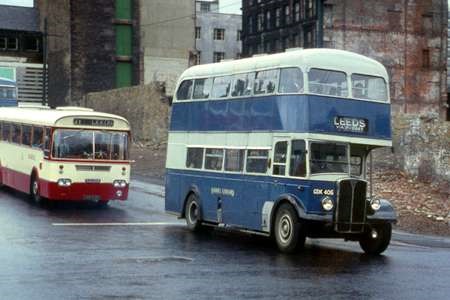
Here is a 1965 shot of fellow ex Rochdale Regent GDK 405 leaving in the company of a Hebble Reliance amid the wanton destruction of historic Bradford to facilitate the encroachment of soulless architectural excrescences.
Roger Cox
29/07/19 – 06:37
Regarding this latest shot added I think you will find that the "Hebble Reliance" is actually a Ribble Leopard on service J1.
John Kaye
29/07/19 – 06:38
Roger,
I may be wrong but the "Hebble Reliance" looks to be Ribble Leopard.
John Blackburn
29/07/19 – 06:39
A great action shot of two most handsome vehicles Roger, as they no doubt vie for pole position on their way to Chester Street Bus Station. I totally agree with you regarding the wanton destruction of historic Bradford. Many wonderful gems have been lost over the years and even the lovely view of Forster Square with its Victorian Post Office and Cathedral backdrop can no longer be seen from the bottom of Cheapside, as the new all-encompassing Broadway shopping complex completely blocks it. Now sorry to nitpick slightly Roger, but that Hebble Reliance looks suspiciously like a dual-purpose Ribble Leopard to me…
Brendan Smith
30/07/19 – 07:36
Thank you for the corrections, gentlemen. I should have looked more carefully at the Hebble vehicle. You can’t get away with sloppy work on OBP.
Roger Cox
Further to my previous abject apology, a very close study of the original slide reveals that the vehicle behind the Ledgard Regent is, indeed, Ribble Leyland Leopard PSU3/4R, Marshall DP49F No.831, CRN 831D.
Roger Cox
